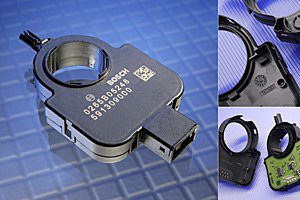Home > Press > Safely negotiating the curves
 |
| Bosch’s steering-angle sensor made from Ultradur® High Speed |
Abstract:
Filigree steering-angle sensors made by Bosch using Ultradur High Speed
Safely negotiating the curves
Ludwigshafen, Germany | Posted on February 4th, 2008The steering-angle sensor that Bosch produces for various renowned international car manufacturers is now being made of Ultradur® High Speed, BASF's very easy-flowing PBT. This plastic allows injection molders not only to markedly shorten the cycle times, but also to make their components with an even more filigree design. The steering-angle sensor plays an integral role in the safety of vehicles and provides the electronic stability program (ESP) with information about the position of the steering wheel. This is why this part and its electronics are located directly on the steering column.
The latest generation: thin-walled and laser-writable
Following the first sensor generation made of Ultradur B4300 G4 LS High Speed (20% glass fibers), Bosch recently went into serial production with its newly developed sensor for the latest generation of automobiles. In view of the ever-growing requirements being made in terms of space, the new steering-angle sensor had to have even thinner walls and an even more filigree construction than its predecessor. When standard PBT is used, only one-third of the intricate injection-molding tool can be filled. In contrast, with the easy-flowing Ultradur High Speed, whose good processing properties are due to BASF's specially devised nanotechnology, the sensor can be manufactured without any problems.
Moreover, the steering-angle sensor made of this plastic can be laser-written with a high degree of contrast, so that the parts can be marked with very fine so-called data matrix codes containing a wealth of information about the part on a very small surface area. Since the material can replicate details very precisely, thereby adhering to Bosch's narrow tolerances, the sensor can be configured very flexibly, depending on the car model and on the desired functionality. This BASF PBT has also successfully made the transition from screw-in to snap-on connections.
Worldwide cooperation
The development work is conducted by Bosch at its site in Abstatt, Germany, but the components themselves undergo final optimization and are assembled by Bosch's Australian subsidiary. BASF experts from Melbourne, Singapore and Ludwigshafen were involved, seamlessly integrating product know-how and regional expertise. This material has now been approved for use at all Bosch facilities worldwide.
Ultradur High Speed
The BASF polybutylene terephthalate, which has been modified with a special nanoadditive, serves to replace a standard PBT here. The improved flowability of this innovative product allows users to lower the processing temperature as well as the injection and holding pressures in the injection-molding machine. Energy savings of up to 20 percent can be attained and the cycle time can be reduced by up to 30 percent. As an alternative, the tool can have a simpler design and new components can have thinner walls, which translates into considerable material savings. The number of rejects also drops since the tool can be filled more easily with this easy-flowing plastic.
####
About BASF
With business partners in over 200 countries, BASF is the world’s leading chemical company with more than 150 production sites worldwide and over 95,000 employees. Headquartered in Ludwigshafen, Germany, where the company operates the world’s largest integrated chemical complex, the BASF Group comprises more than 160 subsidiaries and affiliates.
For more information, please click here
Contacts:
Michael Grabicki
Phone: +49 621 60-99938
Fax: +49 621 60-20129
Sandra Magin
Phone: +49 621 60-20916
Fax: +49 621 60-92693
Copyright © BASF
If you have a comment, please Contact us.Issuers of news releases, not 7th Wave, Inc. or Nanotechnology Now, are solely responsible for the accuracy of the content.
| Related News Press |
News and information
![]() Researchers develop molecular qubits that communicate at telecom frequencies October 3rd, 2025
Researchers develop molecular qubits that communicate at telecom frequencies October 3rd, 2025
![]() Next-generation quantum communication October 3rd, 2025
Next-generation quantum communication October 3rd, 2025
![]() "Nanoreactor" cage uses visible light for catalytic and ultra-selective cross-cycloadditions October 3rd, 2025
"Nanoreactor" cage uses visible light for catalytic and ultra-selective cross-cycloadditions October 3rd, 2025
Sensors
![]() Sensors innovations for smart lithium-based batteries: advancements, opportunities, and potential challenges August 8th, 2025
Sensors innovations for smart lithium-based batteries: advancements, opportunities, and potential challenges August 8th, 2025
![]() Quantum engineers ‘squeeze’ laser frequency combs to make more sensitive gas sensors January 17th, 2025
Quantum engineers ‘squeeze’ laser frequency combs to make more sensitive gas sensors January 17th, 2025
Announcements
![]() Rice membrane extracts lithium from brines with greater speed, less waste October 3rd, 2025
Rice membrane extracts lithium from brines with greater speed, less waste October 3rd, 2025
![]() Researchers develop molecular qubits that communicate at telecom frequencies October 3rd, 2025
Researchers develop molecular qubits that communicate at telecom frequencies October 3rd, 2025
![]() Next-generation quantum communication October 3rd, 2025
Next-generation quantum communication October 3rd, 2025
![]() "Nanoreactor" cage uses visible light for catalytic and ultra-selective cross-cycloadditions October 3rd, 2025
"Nanoreactor" cage uses visible light for catalytic and ultra-selective cross-cycloadditions October 3rd, 2025
Automotive/Transportation
![]() Sensors innovations for smart lithium-based batteries: advancements, opportunities, and potential challenges August 8th, 2025
Sensors innovations for smart lithium-based batteries: advancements, opportunities, and potential challenges August 8th, 2025
![]() Simple algorithm paired with standard imaging tool could predict failure in lithium metal batteries August 8th, 2025
Simple algorithm paired with standard imaging tool could predict failure in lithium metal batteries August 8th, 2025
|
|
||
|
|
||
| The latest news from around the world, FREE | ||
|
|
||
|
|
||
| Premium Products | ||
|
|
||
|
Only the news you want to read!
Learn More |
||
|
|
||
|
Full-service, expert consulting
Learn More |
||
|
|
||








